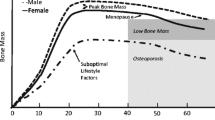Abstract:
The influence of pregnancy on bone mineral density (BMD) was evaluated by dual-energy X-ray absorptiometry (DXA) in 73 women (mean age 29 years, range 20–44 years) postpartum. Fifty-five age-matched women served as controls. The influence of lactation was evaluated in 65 of the delivered women who were followed with repeated measurements, a mean of 4.5 ± 0.1 and 11.5 ± 0.1 months after the delivery. The influence of multiple pregnancies was evaluated in 39 premenopausal women (mean age 38 years, range 31–54 years) with a minimum of four pregnancies (range 4–7). Fifty-eight age-matched healthy premenopausal women with a maximum of two pregnancies (range 0–2) served as controls. Data are presented as mean ± SEM. BMD data are adjusted for differences in total fat mass and total lean mass. Lumbar spine BMD was 7.6 ± 0.1% and total body BMD 3.9 ± 0.1% lower in women postpartum compared with controls (both p<0.001). BMD did not decrease significantly in non-breastfeeding mothers. Mothers breastfeeding for 1–6 months decreased femoral neck BMD by 2.0 ± 1.0% during the first 5 months postpartum (p<0.001). No further BMD loss was seen between 5 and 12 months postpartum. Femoral neck BMD 12 months after delivery was 1.3 ± 0.8% lower than after delivery in mothers breastfeeding for 1–6 months (p= 0.05). Mothers breastfeeding for more than 6 months decreased Ward’s triangle BMD by 8.5 ± 1.0% and lumbar spine BMD by 4.1 ± 0.8% during the first 5 months postpartum (both p<0.05). No further BMD loss was seen between 5 and 12 months postpartum. Femoral neck BMD 12 months after delivery was 4.0 ± 1.1% lower and Ward’s triangle BMD 5.3 ± 1.9% lower than after delivery in mothers breastfeeding for more than 6 months (both p<0.05). BMD loss was higher during the first 5 months following delivery in the lactating women compared with the non-lactating women (p< 0.05 comparing lumbar spine BMD loss in lactating mothers versus non-lactating mothers). However, in women with a minimum of four pregnancies the BMD was no lower than in age-matched women with fewer pregnancies. Total duration of lactation was not correlated with the present BMD. In summary, pregnancy seem to confer a low BMD with additional BMD loss during 5 months of lactation. Even if complete restoration in BMD was not reached within 5 months of weaning, women with four pregnancies or more had a BMD no lower than women with two pregnancies or fewer. We conclude that neither an extended lactation period nor multiple pregnancies could be used as a risk factor when predicting women at risk for future osteoporosis.
Similar content being viewed by others
Author information
Authors and Affiliations
Additional information
Received: 15 November 2000 / Accepted: 21 March 2001
Rights and permissions
About this article
Cite this article
Karlsson, C., Obrant, K. & Karlsson, M. Pregnancy and Lactation Confer Reversible Bone Loss in Humans. Osteoporos Int 12, 828–834 (2001). https://doi.org/10.1007/s001980170033
Issue Date:
DOI: https://doi.org/10.1007/s001980170033




